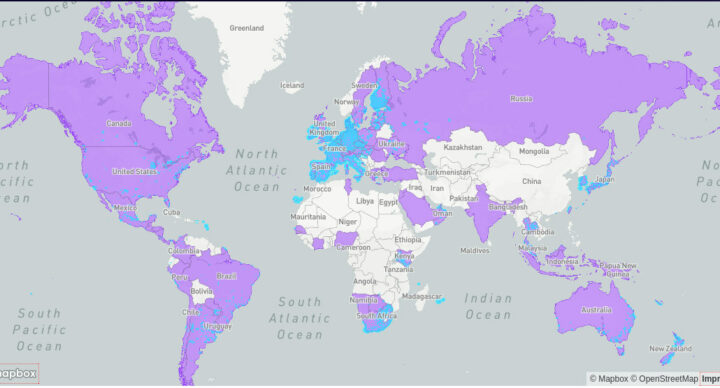While there are many LPWAN standards, in recent years, we wrote mostly about LoRaWAN, NB-IoT & LTE Cat M1/2, as well as Sigfox to a lesser extent. The company managing the latter, also called Sigfox appears to be in financial trouble with the company placed in “redressement judiciaire”, a court-supervised business recovery/turnaround procedure in French law that looks to be similar to Chapter 11 bankruptcy in the US, and sometimes also translated as “receivership”.
LTE IoT standards like NB-IoT and Cat M1/M2 rely on the vast infrastructure established for phones, while LoRaWAN allows the community and private companies to build their own network with gateways, but Sigfox decided to build and own their network and charge a monthly/yearly fee per device to access the network.
Sigfox has extensive coverage in Europe, South Africa, Japan and South Korea, New Zealand, and part of South East Asia, but more sporadic coverage in other regions and countries such as South and North America, Australia, Russia, etc… So I initially thought one of the reasons for the financial trouble may be because of the lack of coverage, and customers would have to rely on Sigfox to create a gateway in locations where it’s needed, while with LoRaWAN or cellular IoT, it’s easy to roll your own or enable it from a base station.
But according to an article on “Notre Temps“, Sigfox blames COVID-19 and semiconductor shortage with a “slowdown of the business activity during the last two years, and a market experiencing a shortage of electronic components for several months”. Those two factors are said to “have heavily weighed upon the financial situation of the company, and especially on its level of indebtedness”.
The receivership covers both Sigfox and its subsidiary, Sigfox France SAS (operator in France), and starts with an initial period of 6 months to find new owners with a plan to maintain the job of most of ~350 employees still remaining with the company.
Via Lup Yuen Lee

Jean-Luc started CNX Software in 2010 as a part-time endeavor, before quitting his job as a software engineering manager, and starting to write daily news, and reviews full time later in 2011.
Support CNX Software! Donate via cryptocurrencies, become a Patron on Patreon, or purchase goods on Amazon or Aliexpress






Sigfox made a terrible bet as if we were still in the dotcom bubble. It’s completely irresponsible for anyone to rely on a technology which forces you to be reliant on a single operator, I actually wonder how they ever managed to get that many customers (they probably didn’t realise how dependent they were).
Running a nationwide network costs a lot of money. A lot. That’s fine as long as you have gullible investors, but once funding stops, it just doesn’t work. Sigfox financials are just fall-on-your-a** horrible. In 2020, they had an operating loss of 20 million euros for 24 million in revenue (and a net loss of 90 million).
The Covid and shortages excuses are just BS. Their 2019 figures were even worse (nearly 30 million operating loss for 21 million in revenue).
They sold the German network last year (it was one of the few they were operating themselves, most others are managed by local partners), but that wasn’t enough.
If you look at the figures for the French network only (which they operate themselves) the figures aren’t better: over 6 million euro operating loss for a revenue of 6 million euros.
Clearly, they are burning cash (they spend more then double their income). This works if you have a pile of cash. They had a substantial one with the money they raised until 2016, but nothing else since then. When you burn cash at this rate and can’t raise more money, you are in trouble.
With their current economic model it seems impossible to me for them to recover: when you have the choice between several alternatives, including LoRaWAN (with multiple operators and the ability to roll out your own if you want/need to) and LTE Cat-M1 and NB-IoT (again with multiple operators), it would be madness to cuff yourself to the single Sigfox operator.
But since they probably promised all local operators that they had exclusivity in their respective countries, they are going to have a hard time switching to a different model. And even if they could, when you have the choice between LoRaWAN which has an extensive ecosystem and the smaller Sigfox ecosystem…
Conclusion: if you are using Sigfox, time to switch! And probably no time to waste…
Well it was a bit predictable… It is not a matter of technology but rather a matter of governance. Just check who is at the head of the board since 2015. Someone who was at the head of Areva (Frenh nuclear group). That person let the company with a 4.5 billion Euros debt (including a scam “Uramine” of 2 billions Euros) that finally the taxpayers have to carry the cost. That person left Areva with a golden parachute of 1.5 million Euros and the protection of the political network, while the justice and journalists revealed bad gouvernance and participation to the scam.
Then when of couple of years later that person was choosen for the board of administration of Sigfox, thanks to BPI France (French sovereign funds) who injected 100 million Euros and the influence of the political network (who was at the board of BPI France at that time?), it was the start of the end for Sigfox, shame. Now the shareholders will pay for the debts of Sigfox, oh dawn it’s BPI France the main shareholder, that means once again the taxpayers will pay the bill.